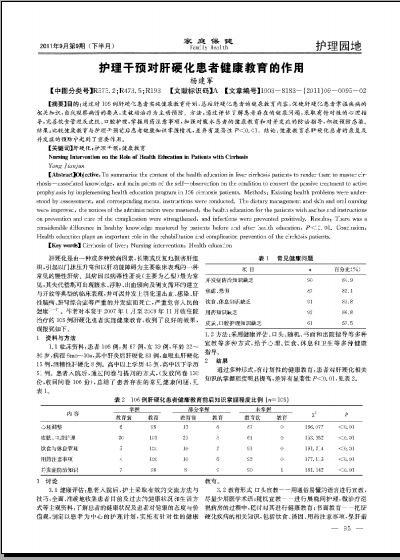护理干预对肝硬化患者健康教育的作用(1)
 |
| 第1页 |
参见附件。
【中图分类号】R575.2;R473.5;R193 【文献标识码】A【文章编号】1003-8183-(2011)09-0095-02
【摘要】目的:通过对106例肝硬化患者实施健康教育计划,总结肝硬化患者的健康教育内容,促使肝硬化患者掌握疾病的相关知识,自我观察病情的要点,变被动治疗为主动预防。方法:通过评估了解患者存在的健康问题,采取有针对性的心理指导,完善饮食管理及皮肤、口腔护理,掌握用药注意事项,加强对腹水患者的健康教育和对并发症的防治指导,积极预防感染。结果:比较健康教育与护理干预前后患者健康知识掌握情况,差异有显著性P<0.01。结论:健康教育在肝硬化患者的康复及并发症的预防中起到了重要作用。
【关键词】肝硬化;护理干预;健康教育
Nursing Intervention on the Role of Health Education in Patients with Cirrhosis
Yang Jianjun
【Abstract】Objective:To summarize the content of the health education in liver cirrhosis patients to render them to master cirrhosis-associated knowledge, and main points of the self-observation on the condition to convert the passive treatment to active prophylaxis by implementing health education program in 106 cirrhosis patients. Methods: Existing health problems were understood by assessement, and corresponding mental instructions were conducted. The dietary management and skin and oral nursing were improved, the notices of the administration were mastered, the health education for the patients with ascites and instructions on prevention and cure of the complication were strengthened, and infections were prevented positively. Results: There was a considerable difference in healthy knowledge mastered by patients before and after health education, P<0.01. Conclusion: Health education plays an important role in the rehabilitation and complication prevention of the cirrhosis patients.
【Key words】 Cirrhosis of liver; Nursing intervention; Health education
肝硬化是由一种或多种致病因素,长期或反复地损害肝组织,引起以门脉压升高和以肝功能障碍为主要临床表现的一种常见的慢性肝病。其病因以病毒性肝炎(主要为乙型)最为常见,其失代偿期可出现腹水、浮肿、出血倾向及侧支循环的建立与开放等典型的临床表现,并可因并发上消化道出血、感染、肝性脑病、肝肾综合症等严重的并发症而死亡,严重危害人民的健康[1-7]。作者对本院于2007年1月至2009年11月收住院治疗的106例肝硬化患者实施健康教育,收到了良好的效果,现报到如下。
1资料与方法
1.1 临床资料:患者106例,男67例,女39例,年龄32~80岁,病程6mo~30a,其中肝炎后肝硬化83例,血吸虫肝硬化15例,酒精性肝硬化8例。高中以上学历45例,高中以下学历61例。患者入院后,通过问卷与提问的方式,(发放问卷130份,收回问卷106份),总结了患者存在的常见健康问题,见表1。
1.2 方法:采用健康评估、口头、随机、书面和出院指导等多种宣教等多种方式,给予心理、饮食、休息和卫生等多种健康指导。
2 结果
通过多种形式,有计划性的健康教育,患者对肝硬化相关知识的掌握程度明显提高,差异有显著性P<0.01,见表2。
表2106例肝硬化患者健康教育前后知识掌握程度比例 (n=106)
3讨论
3.1 健康评估:患者入院后,护士采取有效的交流方法与技巧,全面、准确地收集患者目前及过去的健康状况和生活方式等主观资料,了解患者的健康状况及患者对健康的态度与价值观,制定以患者为中心的护理计划,实施有针对性的健康教育。
3.2 教育形式 口头宣教--用通俗易懂的语言进行宣教,尽量少用医学术语;随机宣教--进行晨晚间护理,做治疗巡视病房的过程中,随时对其进行健康教育;书面教育--把肝硬化疾病的相关知识,包括饮食、诱因、用药注意事项,保肝措施等制作成健康教育处方,发放给患者阅读;出院指导--针对肝硬化患者出院后家庭护理内容 ......
您现在查看是摘要介绍页,详见PDF附件(2640kb)。